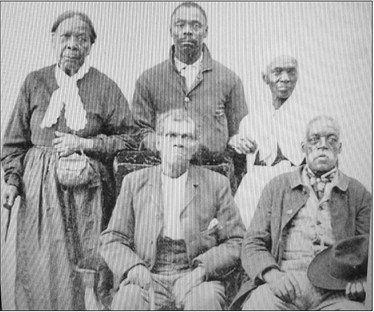Black abolitionist network grew with city

Runaway slave Rodam High Warden was arrested and lodged in the Adams County Jail in 1837. A notice by Sheriff Earl Pierce in the Quincy Argus required Rodam’s owner to come, prove property, pay charges and take the 46 year-old slave away in accordance with Illinois state laws.
Most antislavery Quincyans were born in the U.S. and hailed from European descent. As Quincy grew so did its abolition network, and Americans of African ancestry joined the freedom cause.
Despite state laws, the so-called Illinois Black Codes, which stripped them of their rights, free black Americans in Quincy challenged those restrictions by personally contributing to the economy, raising families and secretly confronting abusive federal laws by operating the legendary Underground Railroad.
Berryman Barnett is one of Quincy’s first known workers for the secret route. He was born in 1800 in Virginia. Barnett’s early history is still sketchy, but by 1838 he had wed Esther Butler in Quincy, and their marriage license lists them as people of color.
William and George were their two sons, and Jane an only daughter, with the family living on Chestnut between Eighth and Ninth streets.
By trade Barnett was a whitewasher who sealed walls and fences with a lime mixture, the same chore that fictional Tom Sawyer tried to avoid in Mark Twain’s classic book (set during the same years as Barnett’s work history).
He is best known for his alliance with Dr. Richard Eells when scouting for escaping slaves on Quincy’s riverfront.
Eells lived atop the bluff at 415 Jersey Street, and on a summer night in 1842 Barnett guided an escaping bondsman named Charley from Monticello, Mo., to his door.
Barnett apparently stayed behind while the doctor and Charley raced up State Street, but they were soon captured by a posse.
Eells was convicted for helping slaves in violation of the Illinois Criminal Code. He appealed and eventually lost in the U.S. Supreme Court, but died before the case was complete.
George Howard was a close neighbor of the Barnetts, living at the southwest corner of Eighth and Chestnut with hiswife, Louisa. His early history is yet unnoted, but he was born about 1829 and working as a chemist and clerk for Henry H. Hoffman’s pharmacy by 1848. Howard is listed as a man of color in Quincy city directories.
Howard mixed and sold foreign and domestic drugs, paints, oils and dyes on the southwest corner of the public square (now Washington Park).
Hoffman was a Marcelline resident and among the Adams County group that went to the Illinois Anti-Slavery Convention in 1837. His home (before later moving to Quincy) was at the mouth of Bear Creek flowing to the Mississippi River, and a hidden space around the fireplace concealed fugitives heading north.
George Howard encountered abolitionists regularly, at work and in his neighborhood, but no direct evidence yet exists that Howard was fighting slavery before the Civil War.
Charles Sidener moved to Quincy by 1848, and later lived on Chestnut between Ninth and 10th streets with his wife, Hester, and son Martin Van Buren Sidener.
Charles had been enslaved but was freed by his Missouri master. His skills landed him a job as a sawyer and engineer for John Van Doorn’s sawmill on the riverfront.
Van Doorn, his employees, and other anti-slavery Quincyans had been perfecting a northern backdoor route to freedom for several years, and Sidener was a key player in the first leg of the Canada flight.
In late 1849, a slave named Henry Stevenson from Audrain County, Missouri, passed through Quincy. His owner was seeking his fortune in the California Gold Rush, and Stevenson was in Quincy with white farmers on business.
He randomly met Charles Sidener, who arranged a trip to Canada that very day. Stevenson was interviewed and photographed in Windsor, Ontario, in 1895, and he confirmed Sidener’s role as a conductor for his journey over four decades earlier.
The Fugitive Slave Act of 1850 required citizens to return runaway slaves to their masters, which increased national tension. Angry abolitionists nicknamed it the “bloodhound law,” and free blacks living in slavery border states were in more danger of bounty hunters who might destroy their freedom papers and drag them into slavery.
In the year after the act passed, thousands of slaves flocked to safety in Canada, where Canadian laws prohibited the surrender of a slave.
Quincy’s freedom team pressed on, and more black abolitionists moved to town in the 1850s, including the Clark family from New Philadelphia. Simeon and Monroe Clark worked for John Van Doorn and helped many victims of tyranny alongside Charles Sidener.
The Clarks brought valuable knowledge to Quincy, as they knew former slave Free Frank McWorter and his family intimately and Frank’s sons had known the route to Canada for many years.
Paul Budroe was another free black man working for Van Doorn. He lived with Monroe Clark near Third and Delaware streets.
When the Civil War began in 1862, Charles Sidener continued fighting and joined the 29th U.S. Colored Infantry, Co. D. He was listed as missing in action at the Battle of Petersburg, Va., at age 40 and is likely buried in a mass grave there.
Berryman Barnett was unable to fight, but his son William joined the 13th Regiment, U.S. Colored Heavy Artillery. William returned to Quincy, and Berryman died a widower in 1870. George Howard enlisted at Alton with the 3rd U.S. Colored Heavy Artillery. In 1866 his wife, Louisa, is listed as a widow, so George likely died in the war.
Simeon Clark fought for the 38th Regiment, U.S. Colored Infantry, Co. F, before moving to Kansas in the early 1870s.
Heather Bangert is a member of Friends of the Log Cabins, has given tours at Woodland Cemetery and John Wood Mansion, and is an archeological field/lab technician.






